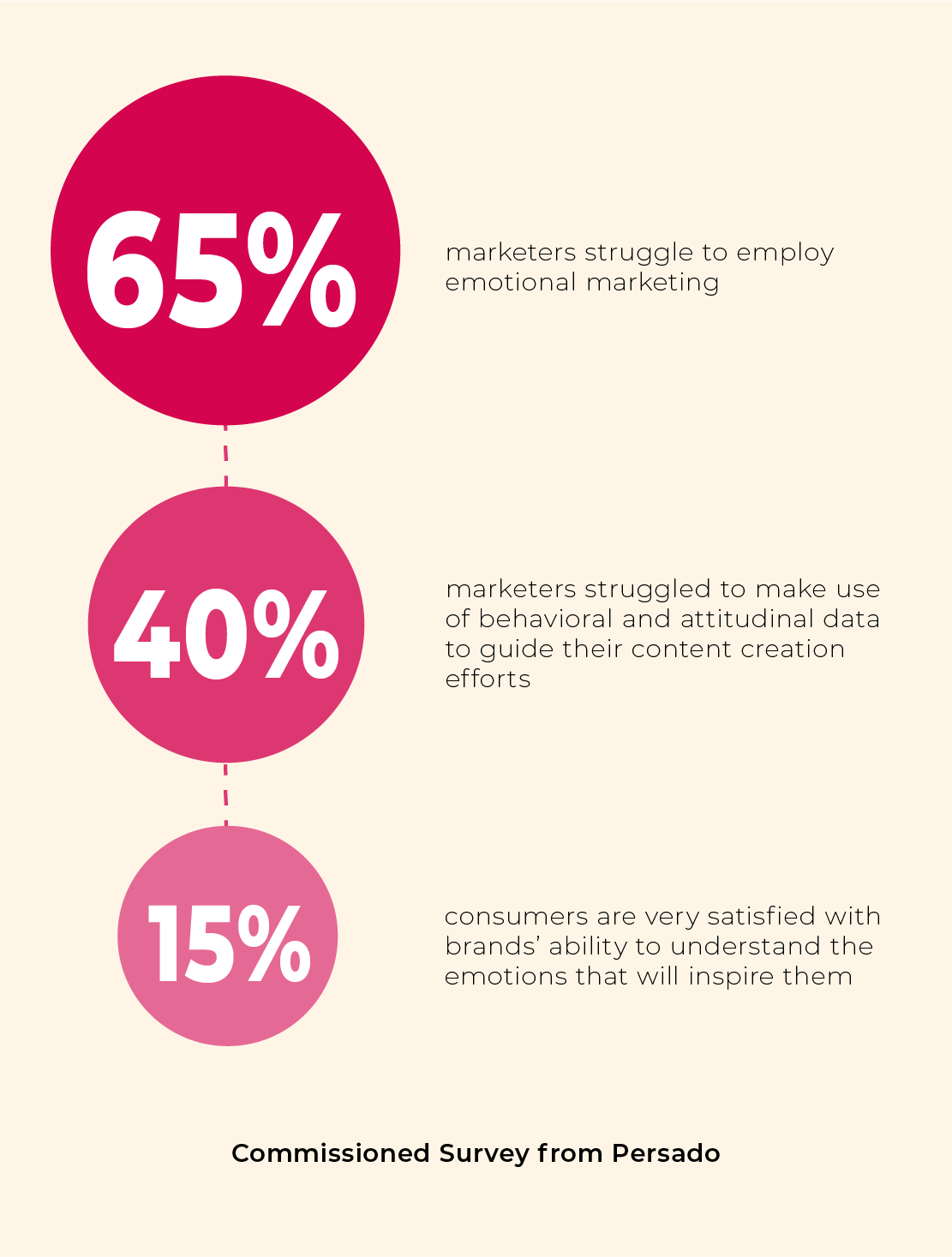
User Intent and Empathy – Why Having a Heart is Essential to Marketing
Marketers today are more empowered to make data-informed marketing decisions than ever before. Every digital marketer today has the ability to roll out targeted marketing campaigns at this point – what was considered a luxury decades ago is now the norm.
But you can have too much of a good thing. In a study commissioned by Persado, Forrester Consulting found that over “65% of marketers struggle to employ emotional marketing”, and 40% of marketers struggled to make use of behavioral and attitudinal data to guide their content creation efforts. This isn’t lost on the consumers, of which the same study found that “…[o]nly 15% of consumers are very satisfied with brands’ ability to understand the emotions that will inspire them to interact, transact and communicate with brands.”
 We’ve previously talked about the importance of creating a strong brand. But a strong brand doesn’t mean that success is guaranteed. You could have the perfect product suited for their needs, but if you aren’t mindful of what the customer is thinking or feeling at that moment, your message isn’t as effective as it could be – a prime opportunity for someone else who has built better rapport with that customer to step in and nab your lead if your product offerings are similar enough.
We’ve previously talked about the importance of creating a strong brand. But a strong brand doesn’t mean that success is guaranteed. You could have the perfect product suited for their needs, but if you aren’t mindful of what the customer is thinking or feeling at that moment, your message isn’t as effective as it could be – a prime opportunity for someone else who has built better rapport with that customer to step in and nab your lead if your product offerings are similar enough.
This doesn’t just mean potential lost customers and earnings, but in the automated world of bidding for Ads, this means that you would have to bid higher for the ad to be shown (if it is even shown at all). On Google Ads, if keywords you’re targeting with your Ad are found to be largely irrelevant, the cost of each click will go up, and the possibility of the ad being shown for that keyword will go down.
So digital tools need to be seen as what they are – tools. Of course, we still need to leverage tools and data, but we also need a little bit of empathy in order to really break through the digital noise and reach our target audiences.
Here are a few tips from us on how to do that.
Think about the Platform’s User Experience – Think Native

Step back for a second and think about what each user is using a platform for.
We don’t just act differently in different situations, we expect things to *be* different as well. This goes for both online and offline. You log on to Twitter, Facebook, and Youtube all for very different reasons that all boil down to this: the type of content you engage in is different for each platform.
Let’s pretend that you are looking to market a product on YouTube, and you are looking to target millennials on the platform.
Consumer insights published on Think With Google showed that “…70% of millennial Youtube users watched YouTube to learn how to do something new or learn more about something they’re interested in… In fact, when learning something new, millennials are 2.7x as likely to prefer to do so by watching a YouTube video compared to reading a book… Thirty-nine percent of millennial YouTube users say it has helped them see the world differently or go through life-changing moments in the past year”.
As a millennial who has taken to using videos as a primary form of learning, I’m guilty of contributing to that statistic. But that aside, think about what this might mean for the marketing content that you would be producing for YouTube. YouTube is a place where content and ideas are shared and discovered.
This might mean sporting a channel of educational content with a slight promotional slant to your products and services. This particular content strategy is widely used amongst a great number of YouTube channels. Through demonstrations of the uploader’s expertise in an area of the viewer’s interest, over time these viewers will be more attuned to whatever products and services this uploader might promote (whether it be their own product or a sponsor’s). And that’s not even considering the Ad Revenue your channel will accrue over time.
An example of this would be Watchfinder & Co., a company in the business of selling pre-owned luxury watches. They also have a YouTube channel with over 400 thousand subscribers, packed with educational content about luxury watches ranging from the quirks of a particular reference number to the impact the Quartz crisis has had on the Swiss watch industry.
In terms of self-promotion, the furthest the channel goes into pushing its brand and services is a small mention of what Watchfinder & Co. is at the end of each video. However, the impacts these educational videos have for Watchfinder & Co.’s website are multi-fold. Without a doubt, Watchfinder & Co. will be receiving a large share of traffic to their site not just from watch aficionados, but also newly minted watch enthusiasts that have grown to love watches through Watchfinder & Co.’s videos. Watchfinder & Co. has not only drawn a larger portion of the existing market, but they have also arguably created new customers by showing, not selling.
Yet the reach and engagement these videos have received have undoubtedly not only increased traffic to their website from watch aficionados, but they have also created demand and established themselves as an authority of luxury watches for those who have been transfixed by the passion that seeps through their videos. Those newly minted watch lovers might just pay a visit to Watchfinder & Co.’s website sometime in the future to purchase their first luxury watch.
In sum, you should not be pushing out videos that are hard-selling a product. You want to make any user watching your content to feel like you aren’t an intruder in their viewing experience (because honestly, you are). You want to make them feel like they are still in their favorite corner of Youtube, and not ushered into a sales pitch.
Because once they do, they’re just going to click onto the next video and return to their viewing experience.
Think about where they are in the purchasing funnel/customer journey
This section definitely is more pertinent for Google Search Ads, but its general principles apply to all aspects of marketing.
Customers searching for a product or service behind the internet are generally somewhere on the marketing funnel. That is, they may be just looking around to see what the product actually is, or they’re searching with the intention of making a purchase as quickly as possible.

The traditional marketing funnel is a model of the customer’s journey from awareness to purchase. People at different stages of the funnel have different attitudes and respond differently to the same things.
So, when you create an ad and bid for something in Google Ads, you need to consider the Search Intent behind the keyword.
How do we do this? Take the keywords you’re trying to advertise for and put them into an incognito Google Search, what kind of organic results pop up? For example, if you are advertising about shoes, are the top organic links informational or transactional by nature (e.g. “Learn more about how to style boots with autumn wear” versus “Buy these shoes at radical prices”). Take a close look at each organic link at the top half of the fold on the first page (basically the first few results at the top half the first page) and see what about their content distinguishes them. Are they solving problems by offering information, or selling a solution?
Analyzing these is important in determining the angle of your ads, because top organic results are Google’s way of saying that these are the best reflection of what browsers are thinking of when they are browsing for something on the platform. So, if you want your ad to be considered to be just as good as an organic link, you need to have the content of your ad align with what the person is looking for in that keyword – just having your ad be shown in relevant keywords isn’t enough.
When you are researching into a product or service, you’re much less likely to respond to sales-driven call-to-actions than if you are money-in-fist, ready-to-make-a-purchase mode. You need to research and think about what state of mind browsers are in when they are searching for those terms and adjust your content accordingly.
Not only that, but if browsers and Google find that your Ad content is largely irrelevant to the keyword that you are bidding for, the cost of bidding for those keywords and to have your ad be shown goes up – it literally doesn’t pay to
To really deep dive into this topic, we can recommend this excellent article published on TenScores about Search Intent and Empathy written by Christian Nkurunzia that goes further into the aforementioned concepts and then some.
Dedicate a Portion of Your Marketing Budget toward Building A Community
 Building a community on sites like Reddit, Facebook, Twitter, or even forums endemic to your own website is now commonplace for many brands, and for a good many reasons.
Building a community on sites like Reddit, Facebook, Twitter, or even forums endemic to your own website is now commonplace for many brands, and for a good many reasons.
Firstly, if your content is valuable and shareable within your community, the content organically spreads far beyond what your marketing budget would consider worth promoting cost-wise. Loyal and active communities distribute and share content.
Second, and perhaps more importantly because of the context of empathy and its importance in marketing design, building a community is important because you now also have 24/7 access to a focus group of sorts.
Putting yourself completely in your customer’s shoes can be hard for some, which is why a lot of companies have turned to give their customer base a voice by building communities so that companies can have access to their customer’s raw takes.
In his LinkedIn Pulse article, Brian Carroll mentioned that “[t]he best marketing and selling feels like helping (because it is)… [and l]ook for ways you can help your customers make their lives better…”. Building a strong community can give you the opportunity to engage, interact, bounce ideas off of, and introduce rough mockups of product prototypes with the community you built and offer you raw insights that you would otherwise have to pay for through marketing research firms.
Most companies who do this have community managers in-house to maintain a constant stream of authentic communication between the company and its fanbase. But this job doesn’t just have to be limited to just community managers, Riot Games employees can be seen frequenting reddit.com/r/leagueoflegends threads engaging and interacting with the fanbase and asking for feedback on the state of the game and ideas/projects currently in the pipeline.
Basically, if everyone is trying to better understand and connect with your target audience, building a community goes a long way towards establishing a stronger relationship and understanding with your audience than your competitors can. If loyalty can be built from that community, it’s going to that much harder for competitors to poach away your customers.
What other things should I take note of?
Widespread access to data has vastly improved marketing efforts. However, that doesn’t mean that you can slack off and fire ads willy-nilly at your target demographic. Empathy and data need to be used hand-in-hand to solve the problems your customers need solving. Take advantage of existing data, take the effort to get to know the customer in their native environments, plan your marketing campaigns based on these insights, and then reflect on post-campaign data results to determine whether or not they believed you really know and provide for what they need.
Otherwise, why else would they buy from you?


